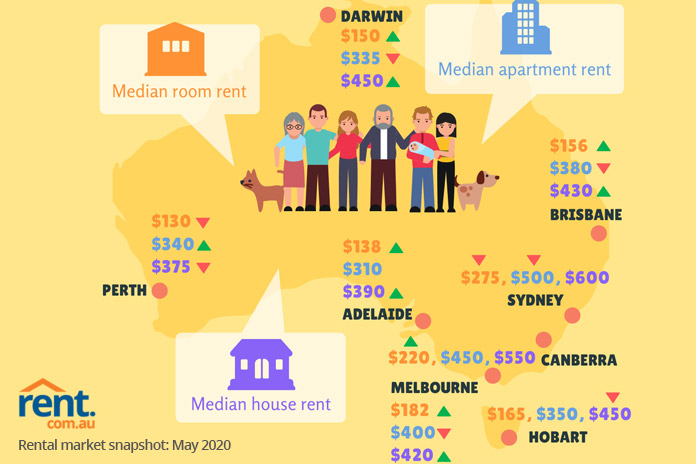With restrictions easing, Australia’s residential rental property market is beginning to show signs of life. Find out which cities are providing the most affordable rents post-pandemic.
The economic impact of the coronavirus crisis has been felt throughout Australia’s property market. The surging unemployment rate, compounded by the uncertainty surrounding the country’s job market, has brought unprecedented challenges to the residential rental property sector.
However, signs of life are emerging as restrictions begin to ease.
“In general, we're starting to see renters return to the market across Australia,” said Greg Bader, chief executive officer of rental property website Rent.com.au. “We are coming through a period of increased supply, so there's still a slight softening in terms of prices.”
Australia’s rental property market post-pandemic
The outbreak has prompted the government to impose border closures and travel bans, which restricted the flow of foreigners – including international students – creating a void in Australia’s residential rental property market.
Additionally, the employment situation in the current economic climate may motivate some tenants to find flatmates or move back with their families to save money, resulting in an oversupply of rental properties.
Rent.com.au’s latest rental market snapshot revealed that increases in property supply, along with market changes caused by COVID-19 restrictions, have led to a slight drop in rental prices.
The report showed that “emerging signs of higher vacancies” in capital cities such as Sydney and Melbourne have caused rents to fall in some areas. This rise in property supply has also created an opportunity for “tenants who are fortunate to still be in a secure financial position” to negotiate for a rent reduction.
“Renters are out there, but not in the same volumes as the time pre-corona,” Bader said. “There's no doubt that demand remains impacted by the continued restrictions on domestic and international travel.”

Cheapest cities to rent an apartment
Sydney is among the cities most affected by the limitations on international travel. The city’s rental market is likely to see conditions weaken as student demand and migration rates drop. Apartment rents in Sydney have already dipped by 3.8% in May, dropping the median rent to $500 per week.
Melbourne is another capital heavily reliant on overseas migration. The city’s apartment median rents were also down 4.8% last month to $400 weekly.
Despite the decrease, these cities, along with Canberra, remained the most expensive locations to rent an apartment.
Adelaide led all metro areas for apartment tenants in terms of affordability. Median rent at the South Australian capital is $310 a week. Darwin, which registered the biggest drop in median price in May, followed at $335. Perth, the only city to post an increase, came next at $340. Hobart and Brisbane rounded the list, with weekly median rents of $350 and $380, respectively.
Cheapest cities to rent a house
Perth posted the lowest median home rents among Australian cities at $375 a week. Adelaide, Melbourne, and Brisbane ranked next in terms of affordability, with renters needing to fork over a median $390, $420, and $430 per week, respectively.
Median home rents were highest in Sydney ($600 per week) and Canberra ($550 per week). Hobart and Darwin tied for third, with median rents costing $450 a week.
Cheapest cities to rent a room
According to Rent.com.au, the price per room metric provides an alternative way at looking at the cost of renting for people planning to share a home and save money.
Bader said that given most property data available has been developed for the property owner (i.e. dwelling price), it was important to have individual measurements that looked at room price breakdowns.
“Our price per room metric is a different way to look at the cost of renting,” he said. “It’s a more accurate representation for people wanting to share a home with others.”
Considering this metric, Perth held the title as the cheapest metro area to rent a room, with a median price of $130 per week. Despite slight increases in room rents in May, Adelaide, Darwin, and Brisbane ranked next at $138 (up 1%), $150 (up 4.6%) and $156 (up 1%), respectively. Hobart rates remained stable at $165 weekly, good for fifth place.
Meanwhile, Sydney was the most expensive city for renters looking for individual rooms, costing $275 a week, despite the price dropping 3.1%. Canberra came next, with median rent of $220. Melbourne followed at $182, an 8.1% rise from April to May.
How to attract renters
Bader emphasised the importance of having a great online presence in wooing quality tenants.
“If you have an investment property and need to find a tenant, then nothing has changed today. You're competing against other properties, so be clear in your description, provide high-quality photos and highlight the positives,” he said.
He also explained that in setting prices, there were many factors to consider.
“Is your property close to everything, or is parking available? Set a reasonable price and check out the market in your local area,” Bader said. “Remember, if a property's showing online, it means it hasn't been leased yet. The homes you can't see are those people have already taken.”
“More than 90% of renters in Australia are searching online, so ensure you make an excellent first impression,” he said.